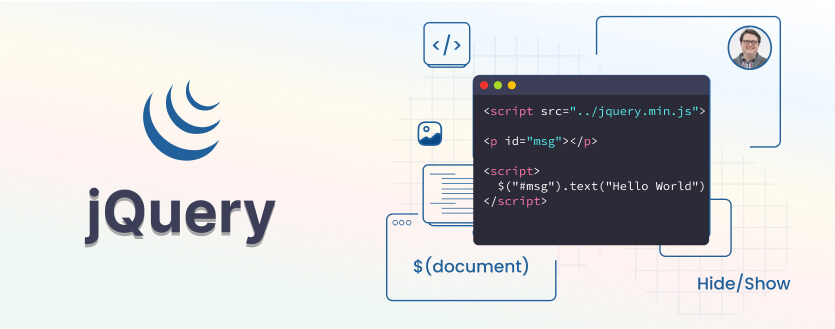jQuery Introduction

jQuery is a fast, lightweight and feature-rich JavaScript library that works on the principle of "write less, do more". Its straightforward API makes it very easy to perform tasks such as HTML document navigation and manipulation, event handling, and adding animation effects to web pages, and it works flawlessly in all major browsers such as Chrome, Firefox, Safari, Internet Explorer, and others. does.
To begin utilizing jQuery, include the jQuery library in your HTML text. You may get the library from the jQuery website or utilize a Content Delivery Network (CDN) to incorporate it in your code directly.
After you've installed the library, you can begin utilizing jQuery by creating JavaScript code that takes use of the jQuery functions and methods. To guarantee that your jQuery code only executes after the HTML document is fully loaded, you usually wrap it inside a document ready function.
jQuery was designed by John Resig in early 2006. As an open-source project, the jQuery project is now administered and maintained by a scattered group of developers. With jQuery, you can save yourself a lot of time and work. So bookmark this page and keep reading.
Here are some of the important features and advantages of utilizing jQuery:
- DOM Manipulation: jQuery makes it easier to pick and manipulate HTML elements in the Document Object Model (DOM). Using CSS-style selectors, you may quickly pick elements and execute actions like editing the content, updating attributes, or changing the element's look.
- Event Handling: jQuery makes it easy to handle events like mouse clicks, keyboard interactions, and form submissions. Event handlers can be attached to elements and defined to conduct actions when events occur.
- AJAX Support: AJAX (Asynchronous JavaScript and XML) allows you to make server-side requests and change sections of a web page without having to refresh the full page. jQuery simplifies AJAX interactions by offering methods for handling requests, processing replies, and dynamically updating page content.
- Animation Effects: jQuery comes with a plethora of animation effects that may be applied to HTML components. Smooth transitions, fade effects, slide animations, and other effects may be created to improve the user experience of your online apps.
- Cross-Browser Compatibility: jQuery abstracts many of the differences across web browsers, guaranteeing uniform behavior and platform compatibility. You don't need to write separate code for various browsers because jQuery resolves inconsistencies for you.
Advantages of Using jQuery
If you're unfamiliar with jQuery, you may be asking what makes it so unique. There are various reasons why one should use jQuery:
- Save lots of time: You may save a lot of time and effort by using the built-in jQuery effects and selections and focusing on other development tasks.
- Simplify common JavaScript tasks: jQuery greatly simplifies typical JavaScript tasks. You may now quickly develop feature-rich and interactive web pages with less lines of code; for example, using Ajax to change a page's content without reloading it.
- Easy to use: jQuery is really simple to use. Anyone with a basic understanding of HTML, CSS, and JavaScript may begin developing using jQuery.
- Compatible with browsers: jQuery was designed with current browsers in mind, and it is compatible with all major modern browsers, including Chrome, Firefox, Safari, and Internet Explorer.
- Absolutely Free: The best thing is that it is entirely free to download and use.
FAQs
jQuery is a fast, lightweight, and feature-rich JavaScript library that simplifies and enhances the process of interacting with HTML documents, handling events, animating elements, making AJAX requests, and manipulating the DOM (Document Object Model). It provides a concise and intuitive syntax, cross-browser compatibility, and a wide range of powerful functions and methods. jQuery allows developers to write less code and achieve more functionality, making it a popular choice for web development. It simplifies common tasks, improves code efficiency, and provides a robust foundation for building interactive and dynamic websites.
To use jQuery in a web page, you need to include the jQuery library by adding a <script> tag to your HTML document. There are two main ways to include jQuery: by downloading it and hosting it on your own server, or by using a content delivery network (CDN). If you choose to download jQuery, you can visit the official jQuery website (jquery.com) and download the latest version. Once downloaded, you can link to the jQuery file using the <script> tag. Alternatively, if you prefer to use a CDN, you can use a link like <script src="https://code.jquery.com/jquery-3.6.0.min.js"></script>. This link points to the jQuery file hosted on the CDN. By including the jQuery library, you gain access to its functions and features throughout your web page.
Yes, jQuery can be used alongside other JavaScript frameworks or libraries. jQuery is designed to work well in combination with other frameworks and libraries, providing additional utility and functionality. However, it's important to consider the compatibility and potential conflicts between jQuery and other libraries, as they may have their own set of methods and syntax. When using jQuery alongside other frameworks, it's recommended to use jQuery's noConflict() method, which allows you to avoid conflicts with other libraries that may also use the $ symbol. By calling jQuery.noConflict(), you can use jQuery instead of $ to reference jQuery functions, ensuring compatibility with other libraries that may rely on $. This way, you can harness the power of jQuery while seamlessly integrating it into your existing development stack.